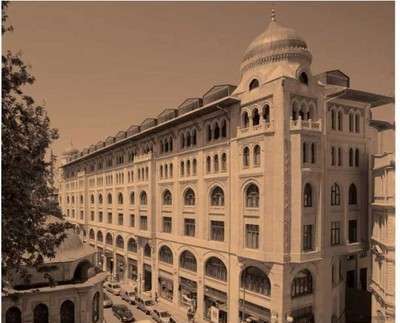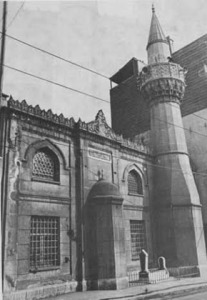Architect (B.
1870, Üsküdar / Istanbul - D. 1927, Ankara). His full name was Ahmed Kemaleddin.
His father was naval officer, Ali Bey. He went to İbrahîmağa primary school.
When his father was on duty in Crete, he learnt
Arabic and French there. In his return, he learnt French with private courses. He
improved his Arabic with madrasah lessons. He studied at Şemsülmaarif ve
Nümune-i Terakki schools. At that point, he started Engineering School
which was newly-opened, and he graduated in 1891. Initially, he became the
assistant of a German architect at the school. After having engaged in
architecture and construction works for four years, he was sent to Germany by
government to accomplish his education.
He studied in Germany
for four and a half years. When he returned, he was assigned as a lecturer of architecture and construction in the Engineering School. He became the Chief
Architect of former Serasker Administration (T.N. Presidency of General Staff)
for a while. He was assigned as the Headmaster of Construction and Maintenance
Department at Ministry of Foundations in 1908 and after that he was assigned as
the Head of Technical Commission at Ankara General Directorate of Foundations. Thanks
to his success in restoration of Mescidi Aksâ', he was elected to the
membership of British Kingdom Institute of Architects. He analyzed Turkish and
Muslim Works profoundly. He broke through in our last architecture art by
combining old Turkish styles and new requirements on the buildings that he
constructed.
Mimar Kemaleddin,
leaving his mark on era and taking part in pioneer implementer of the First
National Architecture Movement, maintained his effects on the people that he
raised, and left a generation who worked for renovation of old works. Through the
beginning of the XX Century, our architecture got into a different form, and foreign
architects and architects of minorities totally had dominated the architecture
act in Turkey.
When evaluated under such conditions, the importance of the Mimar Kemaleddin
and other contemporary Turkish architects clearly comes out.
Kemaleddin Bey realized
various foundation houses, two foundation inns, and a primary school to which
his name was given after his death in Yenişehir, in accordance with his job in
the General Directorate of Foundations in 1926; additionally, upon the request
of Ataturk, he designed a mosque, to be erected in Çankaya, which could respond
to the modern needs. And on behalf of Ministry of Public Works, he started the
design of the building of Turkey
General Directorate of State Railways Station, which was planned to be built
near the Ankara
terminal. Veteran Primary and Secondary Teacher College that he designed on
behalf of Ministry of Education in 1927 led to intense criticism due to the
international style which began to be active in shaping the city in the same
years. After the death of the architect, the 1st National Architecture Period closed with this
building completed in 1930 after which, international formatting understanding
dominated under the thumb of foreign architecture teachers coming from abroad
to Turkish architecture of the period.
With regards to
architecture, the most productive period of Kemaleddin Bey was the ten years
between 1909 and 1919. After Abdülhamit II was dethroned in 1909, with an
attempt to modernization during which there were attempts to renovate and
regulate all government agencies, chief architecture position (directorate) of construction
and repair was established under the Ministry of Foundations and Kemaleddin Bey
was assigned as the chief. The work to restore the most significant old
buildings in Istanbul,
which Kemaleddin Bey commenced as his first work, provided him with getting the
information which helped to improve the national architecture understanding. Among
these works lasting during the 2nd Constitutional Monarchy (1908-1918),
besides big complexes like Sultanahmet, Fatih, Hagia Sophia, Yeni Mosques,
there were the renovation of a number of small mosques and prayer rooms. On the
other hand, in the ministry where the new constructions were designed to be realized
with the purpose of increasing the income of foundations, in accordance with
the suggestion of Kemaleddin Bey, personnel employed in the technical
commission of Construction and Repair Department was enhanced with hired
technicians of various specialties, therefore ensuring the function of this
organization as a huge office of architecture and construction. This office,
which could be named as the “Kemaleddin
School”, enabled to raise
a sequence of architects, engineers and master builders, who applied the
national architecture understanding all around the country, thus technical
commission of Construction and Repair Department at the Ministry of Foundations
turned into the focus point of the 1st National Architecture
movement. Kemaleddin Bey also struggled for foundation of an organization like today’s
union of chamber of Architectures and Engineers and he took part in the
organization called Ottoman Architectures and Engineers Community established
in 1908. It is seen that the mentioned organization had 21 members at that
date, of 11 architect members, just three of them were from the Turkish origin,
and these were Kemaleddin Bey, Vedat Tek, and Halil Edhem Eldem Bey, the
director of Âsar-ı
Atika Museum.
After one year of its foundation, the organization, which had 48 members, 15 of
whom were architects, was ended at the end of the 1st World War must
have been scattered in 1919. Among his compositions he realized in 1910-1911,
which was his most productive period, there were seven big commercial buildings
of belonging to the Foundations, Bebek (1913), Bostancı Kuloğlu (1913), and
Bakırköy Kartaltepe (1923-1924) Mosques and Bostancı İbrahim Paşa, Ayazma and
Eyüp Reşadiye primary schools. Five of foundation houses were built in Istanbul, and two of them were built in Ankara.
It is known that
in the ears he designed schools, mosques, etc. in order to be performed in
different cities of the country. Between 1913-1917, with the aim of satisfying
the Arabs, who tended to break away from Ottomans, a good amount of designs by
Kemaleddin Bey, who was assigned to prosperity attempted in Arabic provinces
were not put into practice due to World War I, and some of the structures that
he designed for Istanbul were left half finished. Of them, mosques in Yeşilköy
and Bakırköy, the IV Foundation House (1916-1926) could only be accomplished in
the first years after the declaration of Republic; the V Foundation House in
Şehzadebaşı was opened, even if not totally completed, again in Republican period.
And even lots of designs could not have been turned into a structure.
MAIN WORKS:
Bostancı Mosque
and School in Istanbul, Ayazma School in Üsküdar, Girl’s High School in Çamlıca,
Bebek and Bakırköy Mosques, Reşadiye School and Tomb in Eyüp, Yeşilköy Mosque,
Tombs of Mahmut Şevket, Cevat, Ali Rıza and Hüsnü Paşa, Foundation Houses from
number one to four, Harikzedegân apartments in Laleli, several madrasahs in vicinity
of Sultanselim, former Medreset-ül-Kuzzat (currently used as the University
Library), Primary School named after him in Yenişehir, Ankara; Atatürk Institute
building in Ankara, Railways Directorate Building next to Ankara Train Station,
Student Dormitory Building in Şehzadebaşı (not completed).
REFERENCE: Ahmet Refik
Altınay / Türk Mimarları (1936), İbrahim
Alâeddin Gövsa / Türk Meşhurları (1946, s. 214), Suut
Kemal Yetin / Türk Mimarisi (1970),
Türkiye Ansiklopedisi (c. 3, s. 904-905, 1974), Metin
Sözen / Cumhuriyet Dönemi Türk Mimarlığı (1984), Ana Britannica (c. 13,
s. 164-165, 1987), M. Kadri Atabaş / Türk Mimarları (2000),
İhsan Işık / Ünlü Sanatçılar (Türkiye Ünlüleri Ansiklopedisi, C. 5, 2013) -
Encyclopedia of Turkey’s Famous People (2013).



